Joy Neal Kidney's Blog, page 72
April 12, 2021
2nd Lt. Daniel S. Wilson
This was written for the Stories Behind the Stars website, which plans to remember every WWII fallen. They provided training and a certain format, including footnotes for research. They even offered to link them to Leora’s Letters: The Story of Love and Loss for An Iowa Family During World War II, but in order to do that I’d need to join something else.
By then, I was finishing up the manuscript for Leora’s Dexter Stories: The Scarcity Years of the Great Depression and was exasperated by trying to jump through all their hoops and gave up.
2nd Lt. Daniel Sheridan Wilson
KIA on a Mission, Schwanberg, Austria
2nd Lt. Daniel S Wilson was born on May 21, 1923, in Stuart, Guthrie County, Iowa. His father, Claiborne Daniel Wilson, and mother, Leora Frances Goff Wilson, were born and raised in Guthrie County. His father was a farmer and raiser of championship Duroc Jersey hogs. Dan had two older brothers who served in the US Navy during the Great Depression and WWII, and two other brothers, who were lost during the war. He also had two sisters.
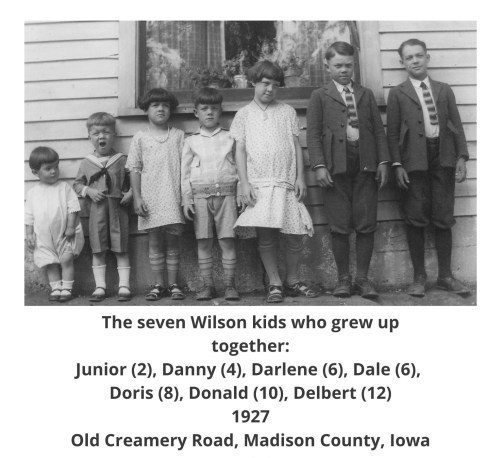
Dan Wilson grew up during the Great Depression in and around Dexter, Iowa. He graduated from Washington Township High School in 1941, valedictorian of his class. Dan farmed with his father and brothers, tenant farmers near Minburn, Iowa, when the war broke out. He enlisted in the US Army Air Force in early 1943.
Basic Training was at Jefferson Barracks, MO in February 1943. He was sent to College Detachment in Cedar Falls, Iowa, in March and April 1943, then Preflight at Santa Ana, CA from May to August, 1943. Primary Cadet Training was at Ryan Field, Tucson, AZ. Basic Training was at Marana, AZ, at the end of 1943. Advanced at Williams Field, Chandler, AZ, graduating in the Class of 44-C. Transition was at Victorville and Salinas, CA, with Tactical Training in the P-38 at Santa Rosa and Hamilton Field, CA.
2nd Lt. Wilson was sent via Liberty Ship to Italy, where he was based at the 15th Air Force Fields in the Triolo area, with the 14th Fighter Group, 37th Fighter Group.
On February 19, 1945, his P-38 was lost after an escort mission to Vienna, then strafing in the Graz area. He was lost near Schwanberg, Austria. Eye witnesses said it was hard to spot a silver plane in a snow-covered area. Lt. Daniel S. Wilson was listed as MIA from that date until January of 1946. By then the military had received information from captured German records through a British Graves Registration team, turned over to an American Graves Registration team who followed up in November 1945. His parents were notified in January 1946. His remains were removed from Austria in August 1946 to the temporary Lorraine American Cemetery at St. Avold, France.
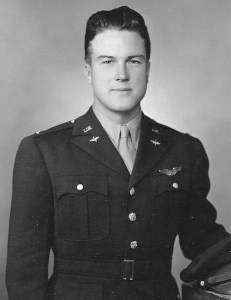
A Purple Heart and an Air Medal with Oak Leaf Cluster were sent to Dan Wilson’s parents.
Dan Wilson was survived by his parents, two brothers and two sisters. His father died in October 1946 of a stroke and a broken heart.
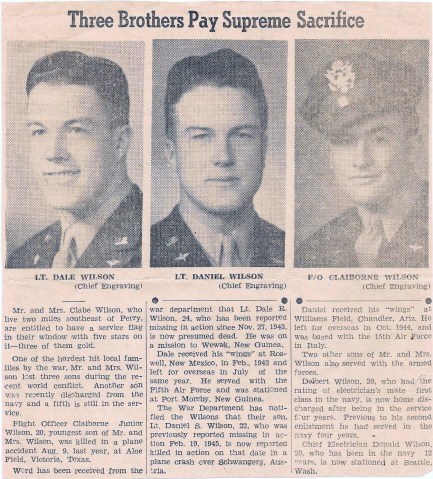
Later his widowed mother made the decision for permanent overseas burial. He is buried in the Lorraine American Cemetery, St. Avold, France.
The five Wilson brothers served in the war. Only two came home. Dan Wilson is one of the three young pilots who lost their lives during the war. His parents had a cenotaph added to the family burial plot at Violet Hill Cemetery in Perry, Iowa for their sons, Dale and Daniel .
The brothers are remembered on the Dallas County Freedom Rock at Minburn, Iowa.
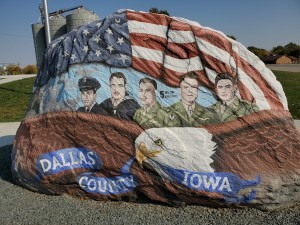
Sources:
Joy Neal Kidney has copies of Lt. Daniel Wilson’s 293 (Casualty) File, Missions Reports, Pilot’s Log Book, letters sent home, telegrams sent to his parents, newspaper clippings. Leora’s Letters: The Story of Love and Loss for One Iowa Family During World War II ADM Alumni Association Honored Military Stories about Dan Wilson. Lorraine American Cemetery https://api.abmc.gov/decedent-search/wilson%3Ddaniel-2 History: Schwanberg 700 Jahre Markt, page 41April 9, 2021
April is National Poetry Month: Four Favorite Poetry Books
To celebrate National Poetry Month, I’m actually going to attempt the challenge to write a poem each day.
Here are some recent favorite collections. You can probably tell that I like accessible poetry.
Kin Types
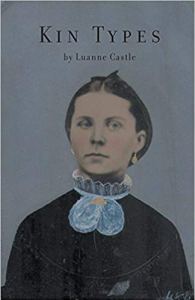
The stories of ancestors help keep them alive. Luanne Castle does that regularly on her blog called “The Family Kalamazoo,” but in this slim volume of 19 poems and flash prose, she captures individuals with a vignette of well-chosen details that give you goosebumps, even a lump in your throat. They are poignant, sharing some harsh scenes as well as how one name is so ubiquitous in her ancestry.
I especially enjoyed the one about family resemblances in old photographs, and noting the names, dates, and places as her forebears crossed the ocean from The Netherlands and Germany and ended up in Michigan. I also enjoyed finding pictures of some of these on her genealogy blog. This delightful chapbook, Kin Types, helps keep alive individuals largely forgotten otherwise.
Luanne Castle’s latest book of poetry is called Doll God.
—–
Rumble & Flash
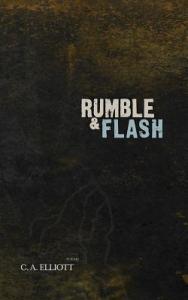
Chad Allen Elliott’s path to poetry began with a love of music. He has performed original songs across the U.S. for over 20-years, winning several awards for composition including the Woody Guthrie Songwriting Award in 2009. Early in his career, he learned some verses do not need musical embellishment. They stand alone in their own cadence. Since that time, this Iowan has penned nearly 2,000 songs and released 22 albums.
In Rumble & Flash, Chad shares poems composed during his time on the road. They are steeped in archetypal themes like fatherhood, love, nature, and spirituality.
Rumble & Flash is full of wisdom from perspective. I especially enjoyed “The Rough Aesthetic of Men,” “One Harmful Thing,” “Refining Years,” and “Bur Oak.”
Chad Elliott’s artwork is also absolutely captivating.
—–
Dust and Diamond: Poems of Faith and Beyond
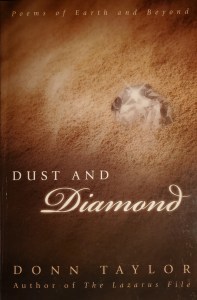
Donn Taylor led an Infantry rifle platoon in the Korean War, served with Army aviation in Vietnam, and worked with air reconnaissance in Europe and Asia. Afterwards, he completed a PhD at The University of Texas and taught English literature at two liberal arts colleges. Now retired from college teaching, he writes suspense and mystery fiction as well as literary poetry designed for the ordinary reader. He lives in the woods near Houston, TX, where he continues to write fiction, poetry, and essays on ethics and U.S. foreign policy.
These poems in Dust and Diamond are wide-ranging, from profound to tongue-in-cheek, all delightful. I especially enjoyed the beautiful “Notation,” the gritty “Panhandle Dust Storm,” “Epigram: 1869,” the miracle of “Ear,” the profound “Terminal Conditions,” and the laugh-out-loud “Fashion Models.”
—–
Horse Lawyer and Other Poems

Greg Seeley was raised on a farm north of Afton, Iowa. He graduated from the University of Northern Iowa with a major in history and received his Master’s Degree from the University of Iowa. Greg is a retired certified public accountant and lives in Overland Park, Kansas with his wife Carolyn, a retired math teacher.
These are delightful and accessible vignettes. What a compelling way to preserve and share the soul of three generations of farm families, through the author’s fatherline in free verse. Not only that, but they lived on the same nook of Iowa soil over a span of 125 years. I’m encouraged to try something similar with my own motherline.
The Horse Lawyer and Other Poems is divided into the three generations and accompanied by winsome photos. I especially enjoyed the poems called “His Rocker,” “Fraternity of the Soil,” and the two about aging–“Two Shall Be As One” and “It’s Getting Gray.”
Greg Seeley also wrote Tractor Bones and Rusted Trucks: Tales and Recollections of a Heartland Baby Boomer, which is a collection of poetry and short stories.
April 7, 2021
Earlham Bricker-Price Senior Series–April 2021
They’ve asked me to speak on the 16th!
 Senior Series, April 2021
Senior Series, April 2021
10:00 Friday mornings, Bricker-Price Block, Earlham, Iowa
April 9 – Darcy Maulsby, Iowa’s Story Teller, and her latest book, Madison County, part of the Images of America Series. While Hollywood made the bridges famous, there are many more stories for Darcy to share.
April 16 – Joy Neal Kidney, Earlham grad, and her upcoming book, Leora’s Dexter Stories: The Scarcity Years of the Great Depression. It’s the prequel to her WWII book, Leora’s Letters. All seven Wilson children grew up in Dexter during the Depression. Some stories are heart-rending, some are funny, and so many episodes are eye-opening. She will also share back-stories.
April 23 – Linda Smith, who is on the Board of the Madison County Historical Society, will give a program about George Washington Carver. Carver was a famous scientist, humanitarian, and artist, but before he ever went to college, he lived and worked in a Winterset hotel. Linda Smith will tell his inspiring story.
April 30 – Brian Downes, Executive Director of Winterset’s John Wayne Birthplace and Museum, will present “A Day With the Duke.” Last year he gave a tour of the museum for the Senior Series via video. Mr. Downes tell stories and connections with the Wayne family that are fascinating. (John Wayne’s roles in military films are featured on the Madison County Freedom Rock.)
Located in Madison County, Iowa, in the small town of Earlham, the Bricker-Price Block (consisting of C.D. Bricker Building, 115 S. Chestnut Ave. on the south, and W. Price Building, 105 S. Chestnut Ave. on the north) occupies the prominent southwest corner at the intersection of First Street and Chestnut Avenue in the Earlham central business district.
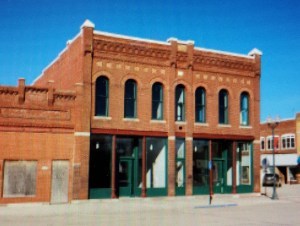
Built in 1900 to house the C.D. Bricker grocery and general store business and leased commercial space in the W.P. Price Building, with second-floor offices above each, the Bricker-Price Block also includes a 1919 one-story rear warehouse addition to the Bricker Building.
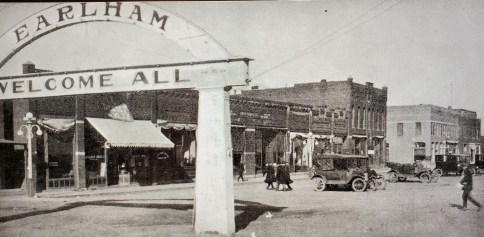
These two adjoining but separately owned buildings were built at the same time by the same builder with a unified façade and matching cast-iron storefronts, and thus the two buildings are jointly known historically as the Bricker-Price Block.
You may enter on the east and climb a flight of stairs, or from the north to use the elevator. It’s their Senior Series, but they won’t check your ID to see if you’re old enough.
April 5, 2021
2nd Lt. Dale Ross Wilson
These next few were written for the Stories Behind the Stars website, which plans to remember every WWII fallen. They provided training and a certain format, including footnotes for your research. They even offered to link them to Leora’s Letters: The Story of Love and Loss for An Iowa Family During World War II, but in order to do that I’d need to join something else.
By then, I was finishing up the manuscript for Leora’s Dexter Stories: The Scarcity Years of the Great Depression and was exasperated by trying to jump through all their hoops and gave up. So I’ll post them here.
2nd Lt. Dale Ross Wilson
MIA Over Wewak, New Guinea, DOD
2nd Lt. Dale R. Wilson was born on May 13, 1921, in Stuart, Guthrie County, Iowa. His father, Claiborne Daniel Wilson, and mother, Leora Frances Goff Wilson, were born and raised in Guthrie County, Iowa. His father was a farmer and raiser of championship Duroc Jersey hogs. Dale had two older brothers, who served in the US Navy during the Great Depression and WWII, and two younger brothers, who were also lost during the war. He also had two sisters, one of them his twin.
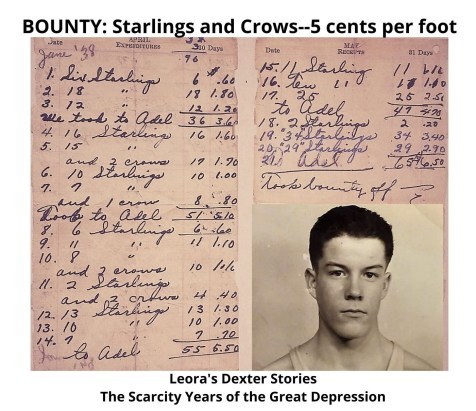 Dale used the bounty money to buy a pair of shoes for his mother, Leora. She’d cut cardboard to cover holes in the soles of hers. He had money left over for his senior class ring and photo.
Dale used the bounty money to buy a pair of shoes for his mother, Leora. She’d cut cardboard to cover holes in the soles of hers. He had money left over for his senior class ring and photo.Dale Wilson grew up during the Great Depression in and around Dexter, Iowa, where he played football, was on a county championship basketball team, and graduated from Dexter High School in 1939. He farmed with his father and brothers, tenant farmers near Minburn, Iowa, when the war broke out. Dale enlisted in the US Army Air Force in May 1942.
Basic Training was at Santa Ana, CA, in mid 1942. Primary Cadet Training was at Hancock Field, Santa Maria, CA. Basic Training was at Gardner Field, CA, at the end of 1942. Advanced at Roswell, NM, graduating in the Class of 43-B. Transition Training was in B-25s at Greenville, SC.
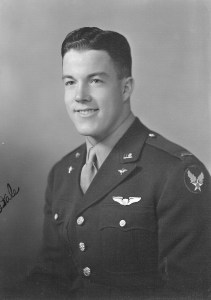
2nd Lt. Wilson was the copilot of a new B-25 which flew from the West Coast, island-hopping to Australia in August 1943, for Tactical Training with the 5th Air Force. He was assigned to the 823rd Bomb Squadron of the 38th Bomb Group based, at 17-Mile Field, Port Moresby, New Guinea, in October 1943.
On November 27, 1943, his B-25 was lost on a mission to Wewak, New Guinea, crashing into the sea near Wewak/Boram. Eye witnesses saw the plane crash.
Dale’s parents received information from three people on the West Coast who had heard a shortwave broadcast March 24, 1944, naming Dale Wilson as a POW of the Japanese. It was never confirmed.
His official Declaration of Death was set for January 15, 1946, which was well after the war was over. Dale Wilson was survived by his parents, two brothers and two sisters. His father would die of a stroke and a broken heart that October.

Five Wilson brothers served in the war. Only two came home. Dale Wilson is one of the three young pilots who lost their lives during the war. His parents had a cenotaph added to the family burial plot at Violet Hill Cemetery in Perry, Iowa, to remember sons Dale and Daniel. Only God knows where Lt. Dale Wilson’s remains lie today, and those of the five other men on the crew that day.
All five Wilson brothers are remembered on the Dallas County Freedom Rock at Minburn, Iowa.

He is memorialized on the Tablets of the Missing, Manila American Cemetery, Philippines.
His family was never awarded his Purple Heart until his niece, Joy Neal Kidney, requested it.
Sources:
Joy Neal Kidney has copies of Dale Wilson’s 293 (Casualty) File, Missions Reports, Pilot’s Log Book, letters sent home, telegrams sent to his parents, newspaper clippings. Pacific Wrecks Leora’s Letters: The Story of Love and Loss for One Iowa Family During World War II Stories about Dale R. Wilson Findagrave Manila American CemeteryApril 2, 2021
The Great Depression Era for Kids
Some of the most satisfying books about the Great Depression have been these two written for kids.
by Cheryl Mullenbach
This is a great resource for any age. It includes a timeline and several pages about the Roaring Twenties to set the stage for the Great Depression.
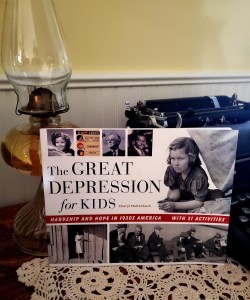
In addition to photographs, there are activities from playing the stock market to interviewing “an elder.” In the back are websites to explore, notes–chapter by chapter, a great bibliography, plus an index.
What sets this book apart is the addition of several activities to enhance learning about the era.
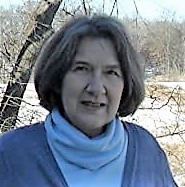 Cheryl Mullenbach
Cheryl MullenbachThe author is a former history teacher and librarian, and has authored several other books.
—–
Children of the Great Depression
by Russell Freedman
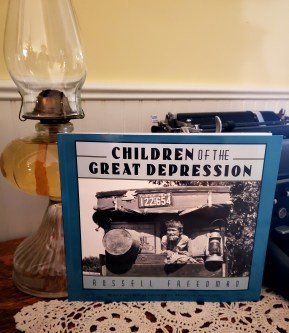
Winner of the 2005 Golden Kite Award for Nonfiction
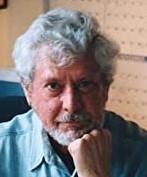 Russell Freedman
Russell FreedmanFeaturing the fine pictures from photographers hired by the Farm Security Administration of FDR’s New Deal, this narrative of the Great Depression is a great resource for any age. It includes Chapter Notes, a Selective Bibliography, and an Index.
Cheryl Mullenbach is also an endorser for Leora’s Dexter Stories: the Scarcity Years of the Great Depression.
March 31, 2021
Soldiers’ Stories: A Collection of WWII Memoirs, Volume II
The Book

For over five years the Miller Family, Myra Miller, PhD, Ken Miller, Del Miller, Marshall Miller, and Lynette Miller Ballard, have zealously gathered memoirs of World War II servicemen and servicewomen. In 2016 they published Soldiers’ Stories: A Collection of WW II Memoirs. Now, on the 75th anniversary of the end of the war, they have given us a second volume. Were it not for the Miller Family, most of these stories would not have seen the light of day. Tom Brokaw popularized the phrase “The Greatest Generation.” Read the stories and you will see why the title is deserved by all 16 million men and women who served so proudly.
Here are the mysteries of courage, the terrors of violence, and the cruelties and coincidences of war. Here, also, are reminders of the humorous events and day-to-day life of those war years. Our first book collected stories our father told us and accounts of other WWII veterans. More narratives demanded a second volume. History is alive. As any veteran will tell you, our future depends on the choices we make now, choices based on our understanding of the past and the meaning of war. Each person’s story speaks of the precious gift of life and our common humanity beyond national borders.
My Thoughts
I was so taken by the first handsome volume of soldiers stories that I submitted stories for this one. The Wilson family story is laid out so well across eleven pages of this treasure. Five brothers served. Only two came home.
 There are nine more pages of information about the Wilson family.
There are nine more pages of information about the Wilson family.The second edition of the book also includes two pages of my dad, Warren Neal. There are two of his brother, Willis Neal, who flew over “the Hump.” My mother’s cousin, Merrill Goff, is also featured.

There are stories of men and women from every branch of the service, some who survived, some who did not. The memoirs are written by the veterans themselves, by family members, or interested friends. There are stories about the Manhattan Project, Red Cross workers, Rosie the Riveter, men who have adopted the overseas graves of American fallen, even one who found dog tags in Belgium and did the research to find family members. One veteran is honored by memories of his 12-year-old great grandson. Michelle Obama’s grandfather’s service is also documented.
As a follower of G. P. Cox’s Pacific Paratrooper website, I was delighted to find four pages dedicated to WWII stories of his father.
 Everett “Smitty” Smith, first of four pages
Everett “Smitty” Smith, first of four pagesThis superbly crafted oversized volume of personal histories would be a fine gift for any history or World War II enthusiast.
Copies autographed by all five Miller siblings may be ordered directly from them.
March 30, 2021
More Our American Stories: The Periwinkle Quilt
 The photo was taken on the clothesline at Mom’s farm, with the granery in the background.
The photo was taken on the clothesline at Mom’s farm, with the granery in the background.This eight-minute story was first aired March 30, 2021.
March 29, 2021
Stuart Bank Robbery Attempt 100 Years Ago–Nightwatchman Killed
Yeggmen, as The Guthrian called them, had stolen a Hudson six in Des Moines from in front of the Orpheum Theater the night of March 29, 1921.
In the middle of the same night, five men ordered breakfast at Stuart’s Princess Cafe, where train crewmen also ate at odd hours. Then they broke into a shed at the Rock Island coal chute, stole a pickax, a sledge, and a chisel which they used to break into the Stuart bank.
At 4:15 that morning, nightwatchman, John Kerr Myers, walking through the alley south of the bank, came upon some of the gang and attempted to arrest them.
A gunfight broke out.
Even though the thugs had cut several nearby phone wires, a woman living over the harness shop, awakened by gunfire, had her son ring up “central.”
Soon the town was roused by the fire whistle.
Finding Mr. Myers wounded, local men took him to a hospital. The would-be robbers didn’t get any cash before they were discovered, but one of three bullets that had hit Mr. Myers severed an artery in his leg. He died at 8:30 that morning.
Stuart men formed a posse and notified surrounding towns of the attempted robbery, also Sheriff C.C. Kennedy of Guthrie County, the Polk County Sheriff, and the Des Moines police department.
According to The Stuart Herald, the town had organized a Vigilance Committee for the purpose of “helping to suppress the wave of crime prevailing in the county.”
A bullet had pierced the radiator of the getaway car. Racing to Des Moines, the criminals stopped at Jungman’s farm near Earlham for gas, and for water for the radiator.
When the black Hudson sped through Van Meter, several men fired shots at it. The car, with bullet holes in it and blood stains on the seats and floor, was found in Des Moines later that morning in a shed in an alley between Locust and Walnut, west of Ninth.
Clabe Wilson was hired as the new nightwatchman, staring pay $73.60 per month. Soon a second man was added.

The town provided a .32 caliber revolver, but Wilson didn’t trust it. Instead, he carried a sawed off shotgun with buckshot and a .45 caliber pistol of his own. When he practiced with his guns north of town, he often took young Delbert and Donald with him.
The State of Iowa offered a $500 reward for the arrest and conviction of the men who tried to rob the bank. The First National Bank of Stuart put up the same amount, and the Guthrie County Bankers’ Association offered $1000 “for the arrest and conviction of the men who murdered Nightwatchman, J. K. Meyers.”

On May 12, John Watters was arrested for the murder of Mr. Myers. The next day Wilsons’ twins, Dale and Darlene, were born.
A second suspect, Dave Masters, was arrested in July. Only the two men were bound over to the grand jury in October, charged with murder in the first degree, and with breaking and entering.
The State asked for the death penalty. Clabe Wilson rode the Liza Jane branch train with other Stuart citizens to watch the trial. In spite of over three dozen witnesses for the State, after 27 hours of deliberation, the jury acquitted both men.
The judge announced that the two still faced breaking and entering charges. They paid $3000 bond each and rode off in a Cadillac with one man’s wife, mother, and sister. . . and the other’s girlfriend.
Were they ever convicted of breaking and entering?
When young Delbert Wilson watched his father go up the street at night, he worried. But he was also proud of him–carrying a gun and wearing a badge.
And all the kids at school knew who his dad was.
—–
 Donald, Delbert, Dale and Darlene, Doris–Clabe and Leora Wilson’s children, later in 1921, Stuart, Iowa
Donald, Delbert, Dale and Darlene, Doris–Clabe and Leora Wilson’s children, later in 1921, Stuart, Iowa
March 26, 2021
Comfort Bird
I noticed carvings in the background of a photo of Gary Knox’s apartment and asked about them. I could tell that they are award-worthy but, in all the years he’s been carving, he hasn’t entered any of them in the Iowa State Fair or anywhere else.

A smaller carving was in front of a photo of Gary and his late wife Verdeen. It looked like a small plain bird. I asked about it. He called it a comfort bird.
What pleasing simplicity. When he first heard about them, he looked up different designs, then made his own. He later asked if I’d like one. I didn’t realize he still did wood working. I was delighted, and asked if he’d walk me through the steps he does to make one.

I looked up “comfort birds” and found dozens of designs and even poems about them. What a wonderful idea to have something attractive, smooth, and just the right size to hold when you need it.
Catalpa is a pretty blond tone and has an nice grain to it. After a trial run with a practice chunk of wood, Gary sawed, chiseled, sculped, and sanded it into the shape he wanted. Then gave it a nice glaze.
My bird rests in a nest similar to Gary’s, although his sits on a bit of his daughter’s tatting.

He also sent a Ziploc bag with the wood shavings. As the daughter of a wood-worker, I love the scent of wood shavings.
He admitted that there’s something about the comfort bird that may just be more satisfying than his more intricate feathered feats.

I agree. And it’s nearly as comforting to glance at as it is to hold it.
 The carver at work
The carver at work
March 24, 2021
Women’s History Month: Doris (Wilson) Neal, Written by her Grandson
By Dan Kidney
(1995)
I never wondered what my grandma’s childhood was like or why she was so optimistic. Even during my early teens, my image of “Granny” was still limited to childhood memories.
When I was in high school, my mom said that Grandma ought to write her memoirs. This struck me as odd. I had never considered Grandma in a historical context – she was just my mother’s mother, the lady with the cat and the cheerful smile.
As a child, I eagerly accepted Grandma’s company and the sugar-coated foods she offered. When I visited her Dexter farm, she always had a bowl of malted milk balls or jelly beans easily accessible to my young hands. (She still does.) Grandma cooked real chocolate pudding and memorable holiday dinners complete with to-die-for dinner rolls.
She enjoyed coming to soccer games and plays that I was in. Her optimism showed through in everything she did. Perhaps the most obvious examples are the names of my mother and my aunt, Joy and Gloria.
I’m glad I had such an idealistic image of my grandma Doris Neal for so long. She was the perfect grandmother–supportive of me and ageless. But the image changed when I asked mom why she thought Grandma should write her memoirs. I grew up a little when she told me.
Mom told how Grandma, then Doris Wilson, was born in a little wooden house during the First World War, the third of [ten] children. Her family moved more than 20 times after losing land during a slump in farm prices after the war and during the Depression.
The Depression was not kind to her family. Whooping cough took the lives of the baby twins, leaving seven children. When I learned how responsible Grandma had felt for her four younger siblings, my respect for her grew. They often ate squirrel or rabbit for dinner. At least once, they only had bread, brown sugar, and water for supper. She never got to go to college, although she got good grades.
Then came World War II. Grandma married a flight instructor who just as the war ended was a B-29 commander scheduled to fly missions over Japan. All five of her brothers served during the war and three never came home – a loss that devastated her family.
She had never let on about any of this to me. Over the months of thinking about Grandma’s history, I have developed a great respect for her.
This woman – who had gone through a lifetime of hard work, hardship, and loss, was the same Grandma who had cooked her special spaghetti for me and came to my choir concerts. She was the amiable grandma that I had always known but was only just now beginning to really see.
 Dan enjoying his grandma’s spaghetti in her kitchen with Youngstown cupboards.
Dan enjoying his grandma’s spaghetti in her kitchen with Youngstown cupboards.Grandma is still as good-natured as ever. We chat over our favorite soup at a local restaurant or play a quick game of cards or try to keep her farmhouse lawn under control. She doesn’t even grab the car’s seat cushions anymore when I take a corner a little too fast with her car.
 Dan and his grandma, 1985.
Dan and his grandma, 1985.And after all this time I have yet to hear a gloomy word from her. Those who deserve praise and respect are those who quietly endure under extreme circumstances and still manage to radiate joy to others. I believe my grandma is such a person. She continues to reinforce my belief by quiet example.
Published in The Des Moines Register, Friday, September 15, 1995.



